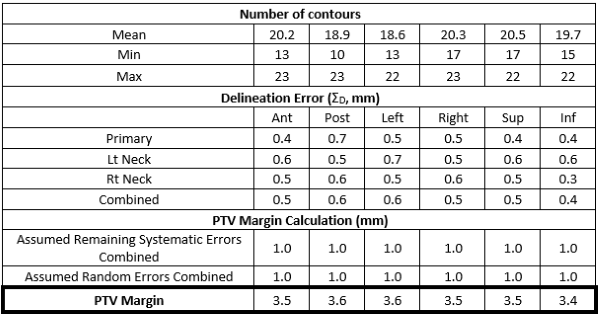Evaluation of UK Pre-Trial Target Delineation Uncertainty To Inform PTV Margins (EDUTIP)
Helen Grimes,
United Kingdom
PD-0580
Abstract
Evaluation of UK Pre-Trial Target Delineation Uncertainty To Inform PTV Margins (EDUTIP)
Authors: David Bernstein1, Helen Grimes2, Keith Rooney3, Rushil Patel4, Chris Nutting5
1Royal Marsden NHS Foundation Trust, Physics, London, United Kingdom; 2University College London Hospitals Foundation Trust, Physics, London, United Kingdom; 3Belfast Health and Social Care Trust, Oncology, Belfast, United Kingdom; 4East and North Hertfordshire NHS Trust, RTTQA, London, United Kingdom; 5Royal Marsden NHS Foundation Trust, Oncology, London, United Kingdom
Show Affiliations
Hide Affiliations
Purpose or Objective
Delineation uncertainty (DU) is often considered the largest source of geometrical uncertainty in modern radiotherapy and can dominate the CTV-PTV margin. Determining appropriate margins requires DU to be measured correctly with enough samples to allow an accurate estimate of this source of error. However, due to various reasons it is often not quantified, potentially resulting in suboptimal PTV margins.
The Evaluation of UK Pre-Trial Target Delineation Uncertainty To Inform PTV Margins (EDUTIP) study aims to address this issue by using national pre-trial protocol compliant outlining exercise data to measure delineation uncertainty for a wide range of anatomical sites. This initial study focussing on primary CTV DU data from the phase III, randomised, multicentre study of dysphagia optimised intensity modulated radiotherapy (Do-IMRT) versus standard intensity modulated radiotherapy (S-IMRT) in head and neck cancer. DARS (CRUK/14/014, Petkar et al, BMC Cancer, 2016).
Material and Methods
CTV DU was measured as the delineation error (ΣD) defined as the standard deviation of the distances of each independently produced RTTQA-reviewed DARS contour, graded as either protocol compliant or having minor deviations, from a reference. Standard deviations were estimated from the range of distances as per Tudor et al (BIR 2020). Prior to measurement, a member of DARS QA team reviewed each contour to ensure protocol compliance at each measurement point to avoid artificial inflation of ΣD and the PTV margin in turn. Measurements were performed separately in cardinal and oblique angles in; the primary site, 3 axial slices in the right neck, and 3 in the left neck.
The van Herk margin recipe was used to calculate the resultant margin, under the assumption that all other sources of systematic error totalled 1mm, as did all random errors.
Results
In total 23 independent contours were considered for measurement, the number used at each point ranged from 10 to 23. The resultant ΣD was <1mm for each cardinal direction resulting in a PTV margin of approximately 3.5mm. See table for breakdown of results.
Conclusion
This study found that 3-4mm CTV-PTV margins are adequate for centres following the DARS protocol, assuming remaining systematic and random errors each combine to ≤1mm. The relatively large numbers of contours used for each calculation highlights the potential of using trial QA data for measuring DU for the purpose of PTV calculations, being much larger than most centres can achieve individually. When measured in single centres, these values often suffer from very small sample sizes resulting in large uncertainties in ΣD itself which transfers to the resultant PTV margin. Following on from this pilot, the EDUTIP study will be expanded to include a wide range of trial data to produce much needed site-specific delineation uncertainty data for use in margin calculations, for a range of anatomical sites and clinical protocols.